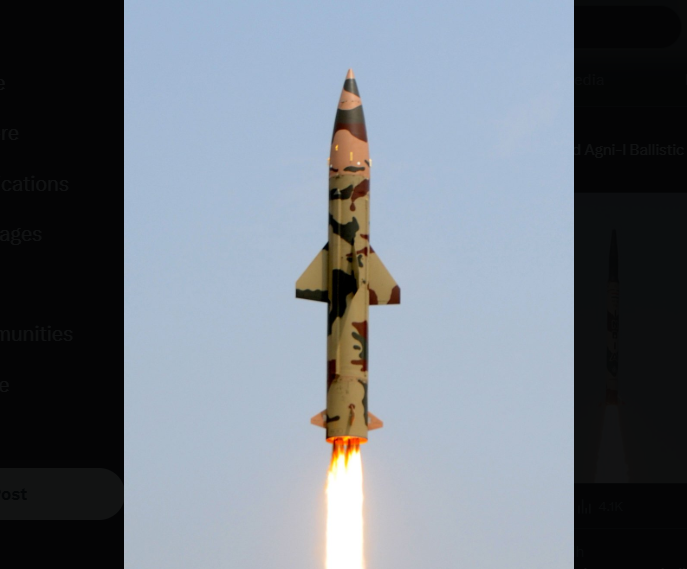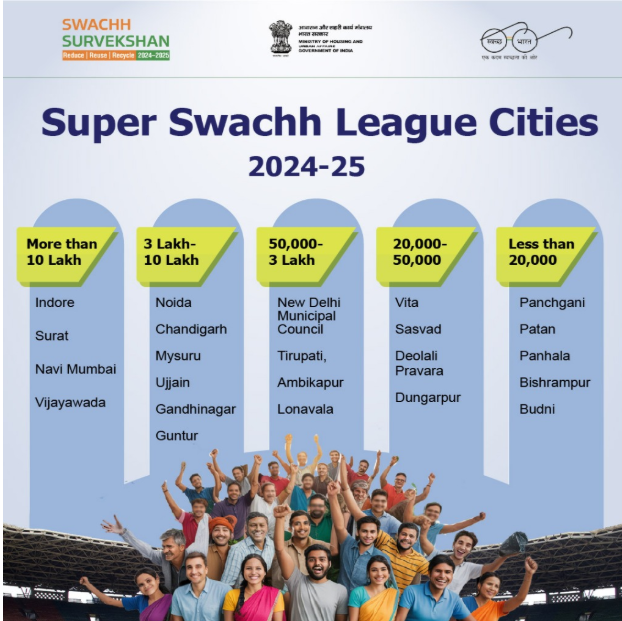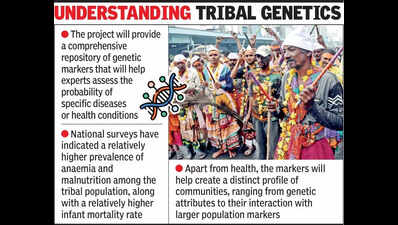Prithvi-II and Agni-I Ballistic Missiles

- 19 Jul 2025
In News:
India recently conducted successful test-firings of its nuclear-capable short-range ballistic missiles Prithvi-II and Agni-I from the Integrated Test Range (ITR), Chandipur, Odisha. The trials aimed to validate operational readiness and technical reliability of India’s strategic missile systems.
These tests follow closely on the heels of the Indian Army's successful high-altitude test of the Akash Prime air defence system in Ladakh, underscoring India’s advancing indigenous defence capabilities.
Strategic Significance
- Conducted by: Strategic Forces Command (SFC) under routine training and validation exercises.
- Developed by: Defence Research and Development Organisation (DRDO) under the Integrated Guided Missile Development Programme (IGMDP).
- Purpose:
- To validate accuracy, technical parameters, and combat readiness.
- To reinforce India’s nuclear deterrence and second-strike capability.
- To ensure strategic preparedness post the May 2025 Indo-Pak conflict.
Prithvi-II Missile: Key Features
|
Parameter |
Details |
|
Type |
Short-range, surface-to-surface ballistic missile |
|
Range |
~350 km |
|
Propulsion |
Liquid-fuelled |
|
Payload Capacity |
Up to 500 kg |
|
Warhead Type |
Conventional and nuclear |
|
Navigation |
Advanced inertial navigation system |
|
Deployment |
Road-mobile launcher |
|
Speed |
Above Mach 1 |
|
Role |
Part of India’s tactical nuclear strike capability |
Agni-I Missile: Key Features
|
Parameter |
Details |
|
Type |
Short-range, single-stage ballistic missile |
|
Range |
700–900 km |
|
Propulsion |
Solid-fuelled |
|
Payload Capacity |
Up to 1,000 kg |
|
Warhead Type |
Conventional and nuclear |
|
Accuracy |
High precision with advanced guidance |
|
Induction |
Early 2000s, operational with Indian Army |
|
Strategic Role |
Integral to India’s minimum credible deterrence posture |
Green Synthesis of Hydrogen Peroxide
- 19 Jul 2025
In News:
Indian scientists at the S.N. Bose National Centre for Basic Sciences (SNBNCBS) have developed a novel, eco-friendly method to synthesize hydrogen peroxide (H?O?) directly from sunlight and water using a photocatalyst called Mo-DHTA COF. This innovation marks a significant advancement in green chemistry and sustainable industrial practices.
What is Hydrogen Peroxide (H?O?)?
- A colorless, bitter-tasting liquid with powerful oxidizing properties.
- Environmentally friendly: Decomposes into water and oxygen without leaving harmful residues.
- Naturally present in trace amounts in the atmosphere.
- Unstable and decomposes readily, releasing heat.
- Found in household use (3–9% concentration) for disinfection, bleaching, and wound cleaning.
Applications
- Medical: Disinfectant, wound cleaner.
- Industrial: Textile and paper bleaching, foam rubber production, and rocket propellant.
- Environmental: Wastewater treatment, green sterilization.
- Energy & Chemistry: Fuel cells, chemical synthesis, and potentially in CO? reduction and water splitting.
Limitations of Conventional H?O? Production
- Energy-intensive and environmentally hazardous.
- Costly and not sustainable for large-scale, decentralized applications.
The Innovation: Mo-DHTA COF
What is it?
- Mo-DHTA COF stands for dimolybdenum paddlewheel-embedded Covalent Organic Framework.
- Developed by a DST-supported research team at SNBNCBS.
- Published in the journal Small.
Photocatalytic Mechanism
- Made from α-hydroquinone-based organic linkers and dimolybdenum units.
- Upon visible light exposure, the material generates excitons (electron-hole pairs).
- Electrons reduce oxygen to superoxide radicals, which then convert to H?O? through further reactions.
- Functions in various media (ethanol, benzyl alcohol, and even pure water).
Advantages of Mo-DHTA COF
|
Feature |
Description |
|
Eco-Friendly |
Uses only water and sunlight—no harmful by-products. |
|
High Photocatalytic Efficiency |
Effective even in pure water, not just organic solvents. |
|
Stability |
Structurally stable and recyclable, suitable for long-term use. |
|
Enhanced Performance |
Overcomes limitations of earlier photocatalysts like metal oxides, g-C?N?, and MOFs. |
|
Scalable |
Promising for industrial upscaling and decentralized chemical production. |
Significance and Future Potential
- Green Chemistry: Sets a foundation for cleaner chemical production methods.
- Healthcare & Pharma: Enables low-cost production of disinfectants.
- Environmental Remediation: Supports sustainable water purification and sterilization.
- Energy & Materials Science: Potential use in CO? reduction, water splitting, and fuel cell technologies.
- Research Outlook: Future focus includes optimization of metal-embedded COFs and exploring other catalytic systems for broader applications.
Akash Prime Missile System

- 19 Jul 2025
In News:
India has successfully conducted a high-altitude trial of the Akash Prime surface-to-air missile system in Ladakh, marking a major step in strengthening indigenous air defence capabilities, particularly for mountainous and high-altitude terrains.
What is Akash Prime?
Akash Prime is an upgraded variant of the Akash Surface-to-Air Missile (SAM) system, developed by the Defence Research and Development Organisation (DRDO). It is designed to operate efficiently in high-altitude, low-oxygen environments—ideal for India’s sensitive border regions like Ladakh and Sikkim.
Developers
- DRDO – Lead developer
- In collaboration with:
- Bharat Dynamics Limited (BDL)
- Bharat Electronics Limited (BEL)
Key Features
|
Feature |
Description |
|
Purpose |
Neutralizes aerial threats like enemy aircraft, drones, and cruise missiles |
|
Altitude Performance |
Successfully tested at 15,000 ft; engineered for deployment above 4,500 metres |
|
Seeker Technology |
Equipped with an indigenous Radio Frequency (RF) seeker for precise target acquisition during terminal phase |
|
Guidance System |
Hybrid: Command guidance + terminal active homing |
|
Range & Speed |
Operates within 25–30 km range; travels at Mach 2.5 |
|
Mobility |
Mounted on mobile platforms for rapid deployment across terrains |
|
All-Weather Capability |
Functions in extreme cold and low-density atmospheric conditions |
|
Kill Probability |
88% (single missile); up to 98.5% in dual-salvo mode |
Operational Significance
- High-Altitude Readiness: Specifically tailored for mountainous regions such as the Line of Actual Control (LAC).
- Versatile Deployment: Protects mobile, semi-mobile, and fixed military installations.
- Strategic Feedback Integration: Incorporates enhancements based on feedback from armed forces for use in vital installations.
Strategic Importance
- Aatmanirbhar Bharat: Fully indigenous system contributing to self-reliance in defence manufacturing.
- Cost Efficiency: Reduces dependency on imported air defence systems.
- Force Multiplier: Strengthens India’s layered air defence network against modern aerial threats.
Swachh Survekshan 2024–25

- 19 Jul 2025
In News:
Swachh Survekshan 2024–25, the world's largest urban sanitation survey, has marked a new milestone in India’s cleanliness journey under the Swachh Bharat Mission–Urban (SBM-U). Conducted by the Ministry of Housing and Urban Affairs (MoHUA), this 9th edition evaluated 4,500+ Urban Local Bodies (ULBs), reflecting deepened citizen engagement and growing competition among cities.
Key Highlights
- Cleanest Big City (10+ lakh population): Ahmedabad (Gujarat) ranked 1st for the first time, Bhopal (Madhya Pradesh), Surat (Gujarat).
- Swachh Bharat Super League 1.0: Introduced for cities with sustained performance—Indore, Surat, and Navi Mumbai led the league.
- Top Mid-Sized Cities (3–10 lakh): Mira-Bhayandar (1st), Bilaspur (2nd), Jamshedpur (3rd).
- Top Small Cities (<1 lakh): Sasvad (1st), Lonavala, Vita.
- Best Ganga Towns: Prayagraj, Varanasi, and Bijnor.
- Cleanest Cantonment: Secunderabad Cantonment Board.
- Best Performing States: Maharashtra, Madhya Pradesh, Chhattisgarh.
- Cleanest State Capital: Bhopal.
- Sanitation Worker Safety Awards: Visakhapatnam, Jabalpur, and Gorakhpur were recognised under SafaiMitra Surakshit Shehar.
Swachh Survekshan Framework
- Launched: 2016 under SBM-U.
- Objective: Foster competition among cities for sanitation and cleanliness.
- 2024–25 Innovations:
- One City, One Award principle for fair evaluation across population sizes.
- Super Swachh League: Honours cities with consistent top-tier performance.
- Real-time monitoring: Integrated Command and Control Centres (ICCCs) used for validation.
- Digital citizen engagement: Over 14 crore citizens participated via apps and feedback systems.
- 3R Emphasis: Focus on Reduce, Reuse, Recycle as a sustainability principle.
Super Swachh League (SSL)
- A newly created elite category within the survey.
- Aim: To promote continuous excellence in urban sanitation.
- Criteria:
- Minimum 3-star Garbage Free City (GFC) rating.
- Consistent top performance in waste management, segregation, ODF++ status, and citizen engagement.
- Population Brackets:
- 10 lakh+ (e.g., Ahmedabad, Indore, Surat)
- 3–10 lakh (e.g., Mysuru, Noida, Chandigarh)
- Below 3 lakh (with revised benchmarks)
Recognitions and Best Practices
- Waste-to-Wealth Initiatives: Recycled waste used to create artistic gifts for dignitaries.
- “Each One Clean One” Mentorship: Top 78 cities to mentor one lower-performing city each.
- Clean Kumbh Operations: Prayagraj efficiently managed waste during the Mahakumbh, which witnessed a footfall of 66 crore pilgrims.
- AI-Based Monitoring: Artificial intelligence tools deployed for cleanliness validation.
- Citizen-Centric Innovations: Apps and grievance portals boosted accountability.
Impact on Governance and Society
- Decentralised Sanitation Success: Cities like Bilaspur and Jamshedpur emerged as sanitation leaders.
- Inclusion of Smaller Towns: Simplified evaluation allowed small towns to compete on equal footing.
- Women & Youth Engagement: SHGs and youth campaigns played a major role in waste segregation drives.
- Job Creation & Entrepreneurship: Growth in green jobs and circular economy-based startups.
- Sanitation Worker Welfare: Greater focus on dignity, safety, and health of SafaiMitras.
Swachh Bharat Mission–Urban (SBM-U)
- Launched: October 2, 2014
- Phase II (SBM-U 2.0): Running from October 1, 2021 to 2026
- Goals:
- Eliminate open defecation
- Ensure 100% scientific waste management
- Make cities “Garbage-Free”
- Aligned with: India’s SDG 2030 goals and Viksit Bharat 2047 vision
Gujarat launches India’s First Tribal Genome Sequencing Project

- 19 Jul 2025
In News:
Gujarat has become the first Indian state to launch a genome sequencing initiative specifically targeting tribal communities. The Tribal Genome Sequencing Project, announced in July 2025, aims to identify genetic health risks among tribal populations and develop precision healthcare strategies.
About the Project
- Name: Creation of Reference Genome Database for Tribal Population in Gujarat
- Launched by: Gujarat Biotechnology Research Centre (GBRC)
- Coverage: 2,000 individuals from tribal communities across 17 districts in Gujarat
- Budgetary Support: Part of the Gujarat State Budget 2025–26
Objectives
- Identify genetic risk markers for inherited disorders such as:
- Sickle cell anaemia
- Thalassaemia
- Hereditary cancers
- Develop personalised healthcare protocols tailored to tribal genetic profiles.
- Detect natural immunity markers to aid targeted medical interventions.
- Promote data-driven tribal health equity and science-led empowerment.
Key Features
- Establishes advanced infrastructure for:
- Sample collection
- Genome sequencing
- Genetic data interpretation
- Enables early detection and targeted treatment for genetically inherited diseases.
- Involves community engagement for inclusive participation and awareness.
- Represents diverse tribal groups, ensuring comprehensive genomic mapping.
Significance
- Healthcare Equity: Bridges the healthcare gap by enabling affordable, preventive, and precision medicine for marginalised tribal communities.
- Scientific Advancement: Provides a genomic reference database for long-term public health research and policy planning.
- Scalability: Sets a precedent for other Indian states to replicate region-specific genomic initiatives aimed at health inclusion.
What is Genome Sequencing?
- A genome is the complete set of DNA in an organism.
- Human DNA comprises 23 pairs of chromosomes, made up of millions of nucleotide bases: Adenine (A), Thymine (T), Guanine (G), Cytosine (C)
- Whole Genome Sequencing (WGS) decodes the exact sequence of these bases, helping identify genetic disorders and traits.
